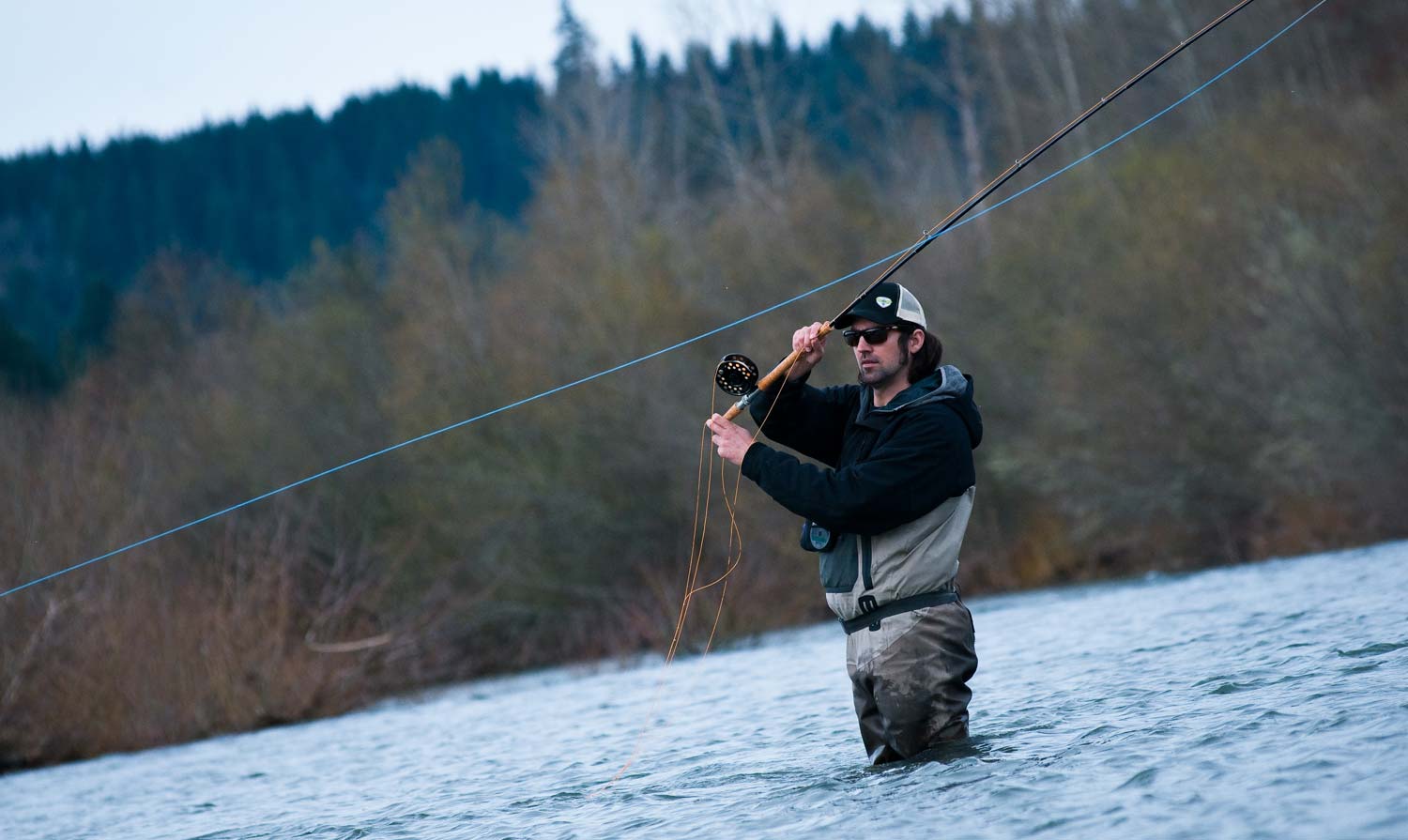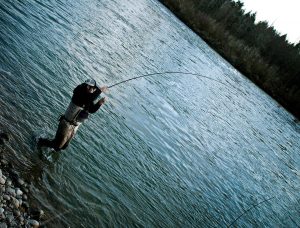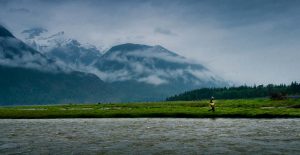
Photos by Louis Cahill
By Owen Plair
In the world of Fly Fishing there was always one style of casting that I never quite understood.
It was some sort of foreign language. An art of casting I’d only seen in videos and photos, but it always seemed so magical. Not to mention how far they could throw a fly line. Why do you use two hands? Why are the rods so long? Whats with these crazy motions on the waters surface to make this giant roll cast? Spey Casting was always a mystery to me, because I never found myself in a fishery where it was needed. Still, I was always curios about it.
That all changed very fast when I stepped off of a helicopter in the middle of the Russian Tundra, in May of 2013. I pursued a once in a lifetime opportunity guiding on the World Renowned Ponoi River, in the Kola Peninsula of Russia. The Ponoi is one of the best Atlantic Salmon Rivers in the entire world and can only be reached via helicopter from the city of Murmansk. What got my attention about the Ponoi was not just the world class fishing but the desire to experience a completely new style of fly fishing. The best way of targeting these Atlantic Salmon on fly is, of course, swinging flies with a two handed rod or Spey Rod. Spey Casting has been very popular in Europe for hundreds of years and has slowly made its way over to the united states, with steel head and salmon anglers using switch rods and spey rods. The rods, lines, leaders, flies, and even reels were all so different than what I was used to. I was stepping into an entirely new world. Thats why I decided to go to Russia.
Before I left for Russia a friend let me borrow his spey rod to get a feel for spey casting and man was I blown away when I put together his 15’ 9wt. The thing felt like a flag pole in my hand! Waving it around on my pond, false casting, roll casting, and having no Idea what to do with a spey rod made me realize I had a lot to learn. I watched youtube videos, read articles, and even talked to some of my clients about spey casting. It was so much harder than I thought it would be and way more technical. One thing I did learn through fly casting, instructing clients, and teaching the National Orvis Fly Fishing School was that fly casting has so much to do with muscle memory and that if you don’t learn correctly from the beginning you are setting yourself up for failure in the end. So after attempting to teach myself I decided to wait until I got to Russia to really perfect the different spey casting techniques and man was that the right move.
 The first thing I learned was that moving water is key and truly helped set up your line for the cast. My first instruction came from Matt Brewer who was the camp manager at the time and a long time guide. Matt could throw a spey rod beautifully. He made it look effortless shooting 70 to 80ft casts. The sound of the fly line ripping through the water as Matt threw the first cast was something I will never forget. Matt taught me the double spey and man was it a humbling feeling, learning how to fly cast from scratch again. That awkward feeling when your muscles and mind are asked to do something they have never done and you feel almost hopeless. Matt was very patient with me and in between the laughs, and sarcasm, I started from the beginning with how to hold the rod, how much line to start with, and most importantly understanding the D loop. Crossing my arms, folding over the line, and swinging back. It all felt odd compared to what I was used to but it also felt pretty awesome learning something completely new in fly fishing. Matt was a true professional and had me casting in no time which led to my first Atlantic Salmon on fly soon after.
The first thing I learned was that moving water is key and truly helped set up your line for the cast. My first instruction came from Matt Brewer who was the camp manager at the time and a long time guide. Matt could throw a spey rod beautifully. He made it look effortless shooting 70 to 80ft casts. The sound of the fly line ripping through the water as Matt threw the first cast was something I will never forget. Matt taught me the double spey and man was it a humbling feeling, learning how to fly cast from scratch again. That awkward feeling when your muscles and mind are asked to do something they have never done and you feel almost hopeless. Matt was very patient with me and in between the laughs, and sarcasm, I started from the beginning with how to hold the rod, how much line to start with, and most importantly understanding the D loop. Crossing my arms, folding over the line, and swinging back. It all felt odd compared to what I was used to but it also felt pretty awesome learning something completely new in fly fishing. Matt was a true professional and had me casting in no time which led to my first Atlantic Salmon on fly soon after.
The D loop is the most important part of the spey cast, because that is how your line loads the rod and creates the energy for a strong forward cast.
As you swing back, mid way through a double spey to create the D loop, you are using your fly line as an anchor on the water, which creates the D shaped loop. Then as you use both hands to cast forward, the D Loop loads the rod with energy to make a forward cast almost as if you had made a back cast! Its a technique that all spey fisherman use and comes into play when fishing banks, structure, or areas where you simply cannot make a back cast. Using the double spey to create a D loop took some time to get a feel for, well, a lot of time! But after 10-20 minutes a day for a week I started to get it down. The timing, and comfortable feeling of understanding a spey cast. I learned a lot from the guides and staff about other spey cast’s including the snap T, Single Spey, and my favorite of them all, the Snake Roll. I learned that all of the casts are based on creating a proper D loop.
When learning the basics of Spey Casting and comparing it to casting a single hand rod, I realized the two had so much in common. Mostly the fact that you have to learn the correct techniques and timing. You have to use your eyes to train your brain, which then trains your muscles. Learning from a professional is always the best route because you get to learn from their vast experience. Of course, a little bit of practice always pays off over time.
 Spey Casting was so popular on the Ponoi, because of the advantage it gave you as an angler. The amount of water you could cover in a short amount of time was key on a large river whether wading the river bank or fishing one angler on each side of the boat. It also allowed you to make long casts, without having to strip in a ton of line and allowed you to use less energy by casting with both hands. Spey casting was the technique of choice because it gave the angler an advantage in that environment. I had some American anglers who used single handed rods and soon learned with great difficulty why the two handed rods were so popular.
Spey Casting was so popular on the Ponoi, because of the advantage it gave you as an angler. The amount of water you could cover in a short amount of time was key on a large river whether wading the river bank or fishing one angler on each side of the boat. It also allowed you to make long casts, without having to strip in a ton of line and allowed you to use less energy by casting with both hands. Spey casting was the technique of choice because it gave the angler an advantage in that environment. I had some American anglers who used single handed rods and soon learned with great difficulty why the two handed rods were so popular.
It took fishing in the right environment for me to truly understand why spey casting is so beneficial. Once you get a feel for the spey cast its amazing how far you can throw a line in just a few simple motions and how efficiently you fish when swinging flies for Atlantic Salmon.
Owen Plair Gink & Gasoline www.ginkandgasoline.com hookups@ginkandgasoline.com Sign Up For Our Weekly Newsletter!
Are you aware of any upcoming opportunities for newbies to learn how to spey cast such as spey camps ? From your article, I gatherer that running water, an experience teacher and some time are required. Is there any economical ways to get those ? Is there another approach such as just working with an FFI 2H Instructor? Any recommendations would be greatly appreciated. I bought an Echo Compact Spey Rod ( 12′ 8wt ) and a Sage Spey Reel ( 7-8-9 ) with OPST 40 Running Line, etc. I want to target Salmon and Steelhead in Michigan and hopefully the west coast and someday Alaska … you know … right after I learn how to cast this thing LOL.